Newsletter: International Suicide Prevention Day 2016
Dear Friends,
The World Health Organization (WHO) estimates that each year approximately one million people die by suicide, which represents a global mortality rate of 16 people per 100,000 population. It is the seventh leading cause of death globally among women aged 20-59. What is alarming is that India has one of the highest suicide rates in the world, where the rate among young women is 10 times the world average.
To highlight this serious issue as an integral part of our mission, we held our annual conference for the second year in a row at Mumbai University on 10 September 2016, on the eve of International Suicide Prevention Day. It was a very successful event with over 250 people attending and learning the devastating effects of suicide and that with proper education, help and medical intervention it can be prevented.
We must discuss suicide as we would any other public health issue if we are to dispel myths and stigma surrounding it and reduce suicide. Be caring and look out for others who may be struggling. Let them tell their story in their own way and at their own pace. Listen without judging. Those who have been affected by suicide have much to teach us in this regard.
Too many lives are lost each year to suicide. Please get involved! Your generous contribution will help us expand our efforts. Together, we can work towards reducing death by suicide and the stigma attached to it.
Warm Regards,
Gayatri Datta,
Founder and President
Sisters Living Works
10132 Ashburton Lane
Bethesda, MD 20817 USA
International Suicide Prevention Day
Care, Connect and Communicate
September 10, 2016
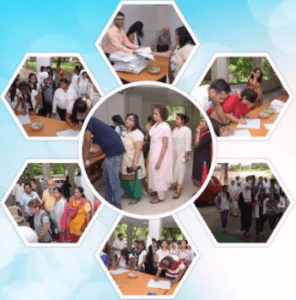
The second annual Sisters Living Works Suicide Prevention Day Conference was held at Mumbai University on 10 September. We were extremely encouraged to see over 250 students, staff, and community citizens join us in the fight to prevent suicide. As our guests arrived, a documentary on teen depression prepared by the American Foundation for Suicide Prevention (AFSP) was screened. Following the documentary, Sisters Living Works founder, Ms. Gayatri Datta, spoke about the organization’s mission to understand, educate and raise awareness about the high rate of suicide in particular among women in India. In India, death by suicide occurs at a younger age in women, average age 25, than in men, average age 34. According to Dr. Vikram Patel, a leading researcher, the risk of completing a suicide was 43% higher in men, who finished secondary or higher education, in comparison to those who had not completed primary education. Among women, the risk increased to 90%. “We, as members of society, must work together to help prevent suicide,” concluded Ms. Datta.
Ms. Anuradha Karegar, who has been with the organization since its inception, welcomed our guests and speakers: Dr. Harish Shetty, Psychiatrist from Hiranandani Hospital; Dr. Shankar Das from Tata Institute of Social Sciences; Mr. Raja Bhau Shelke, from NAAM Foundation; and Mr. M.P. Nicholson, a media consultant and content writer based in Mumbai. Ms. Karegar highlighted an impressive milestone reached in our efforts to educate and raise awareness. Initially, organizations were uncomfortable and reluctant to allow us to conduct workshops on “Suicide Prevention” due to the stigma, but eventually welcomed the workshops and requested more. “We have reached more people than we imagined and this is just the beginning,” said Ms. Karegar. She went on to say, “We have a lot of work ahead and are delighted and encouraged to see so many have come to support us.”
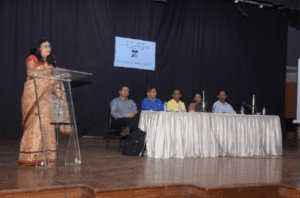
Left to Right: Ms. Karegar, Dr. Shankar Das, Dr. Harish Shetty, Ms. Gayatri Datta, Mr. Shelke, and Mr. Nicholson
Dr. Harish Shetty told the audience “We should celebrate the small joys we experience everyday. Amnesia of the positives and exaggeration of the negative is a cause of depression in the society.” Dr. Shetty emphasized the importance of being in touch with our feelings and encouraged the audience to share and spread awareness about “magnifying our happiness” which in turn can help in “minimizing our pain.” Being observant and caring for those around, noticing behavioral changes is crucial to suicide prevention and reducing suicide attempts. Suicide affects the entire community and yet suicide prevention is low in priority for governments and policy makers, despite evidence that many suicides are preventable. “We should all become involved in raising awareness of suicide as a public health issue and work towards getting government involved in the cause of suicide prevention.”
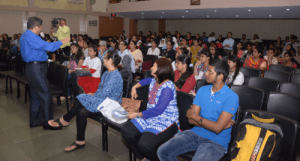
Dr. Shetty, engaging with the audience
With the objective to address the shortage of mental health professionals in the country, 15 Centers of Excellence in Mental Health and 35 training departments in mental health specialties have increase the training capacity in mental health, and have improved tertiary care treatment facilities through funding from the Mental Health Policy, said Dr. Shankar Das.
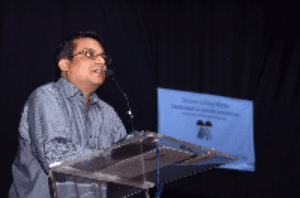
Dr. Das, who works in the field of mental health research, said more government involvement and funding at a level that is commensurate with suicides significance as a public health problem, is urgently needed. Dr. Das emphasized that investing and increased funding in mental health and the social sector services is critical in reducing the number of suicides. He also presented statistics showing suicide to be one of the leading causes of death in India, particularly among the young and women in India.
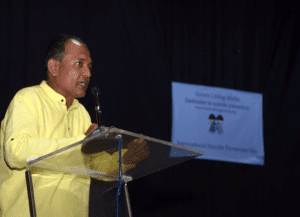
Mr. Rajabhau Shelke introduced the audience to the tragedy of Farmer’s Suicide in India. Approximately 9 farmers lose their lives to suicide each day due to the drought that has affected Maharashtra State. Droughts make it difficult for farmers who depend on their crops for their livelihood. Unable to provide for their family, bankruptcy and debt make these desperate farmers feel hopeless and resort to suicide. The end result is that the wife and family now have lost their sole breadwinner to suicide and are even worse off.
Mr. Shelke, who works for the NAAM Foundation,which help farmers in drought-stricken areas of Maharashtra, brought the plight of farmers and their families to the Government of India. The Government assured him that within the National Policy for Women, they would design special provisions for widows of farmers for alternative livelihood options. Mr. Shelke showed a short documentary highlighting the issues and dilemmas faced by farmer suicide survivors and his organization’s action to support these families. “Droughts can be prevented by canalizing the rivers of Godavari for Marathwada, Bhogavati River of Kolhapur, etc., which can help the cultivation in the upper and lower parts of Maharashtra,” said Mr. Shelke.
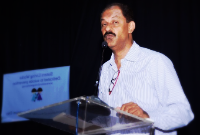
Mr. M. P. Nicholson, a writer and a media consultant, urged all individuals reporting on suicide to be sensitive toward the issue and highlighted the WHO guidelines on reporting suicide. Over the past few decades there has been significant research into media coverage of suicide and how it can affect behavior. Research shows that when the media applied caution in the reporting of suicide, there were positive outcomes, potentially reducing the number of additional deaths. This academic research has been conducted mainly around “mainstream” media, such as television and print newspapers, but there is growing interest among researchers to investigate the possible influence of digital media on suicidal behavior.
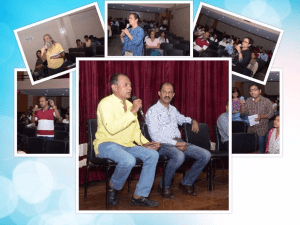
After the presentations, the floor was opened for questions from the audience. “What should be done when our friend is talking about wanting to end his/her life?” an attendee asked. “Listen to them and help them find an adult or medical professional,” responded one of the counselors. “What if they call from near a bridge and tell me that he/she is going to end his/her life by jumping off the bridge?” “Keep talking to them to buy time as you think of ways to rescue the person,” explain Dr. Shetty. One of the attendees provided information on government run helpline numbers, should such emergency situations arise. Mr. Shelke was asked about what other interventional strategies could help in preventing suicide besides water management and irrigation. Mr. Shelke explained that the farmers’ ability to provide a livelihood would help solve this problem. Someone from the audience highlighted the important role of yoga and meditation in helping prevent suicide and another discussed dance therapy’s positive effect on people experiencing depression, in not only healing but also further strengthening mental reserve.
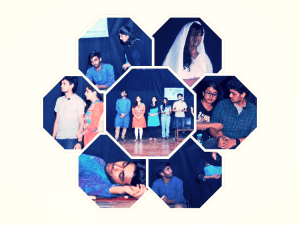
Finally, the students of St. Xavier’s College, Mumbai, presented a play, “Adhuri Zindagi,” (Short Life) which theatrically depicted personal issues that can lead to suicide, but how with support it can be prevented. The play tells a simple story of a young girl’s attempts to end her life after experiencing loss from her father’s death, financial worry and feeling cheated on by her boyfriend. The script and acting were commendable and showed how with the support of family, friends and professionals, she overcame her depression and suicidal thoughts and continues to live a healthy life.
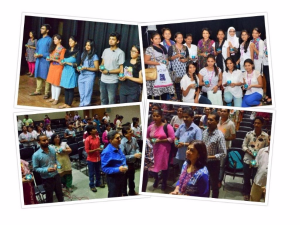
The event ended with all present pledging to care, connect and communicate to prevent suicide. In a gesture of solidarity, everyone lit a candle and maintained a minute of silence in remembrance of loved ones lost to suicide.
Individuals:
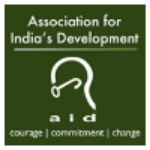

Sisters living works is a 501(c)3 nonprofit organization dedicated to suicide prevention among women in India.
© Copyright 2017 Sisters Living Works.
Developed By Risevertise Media
